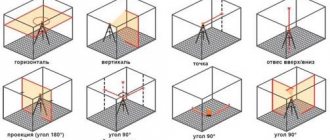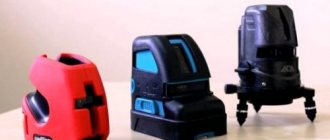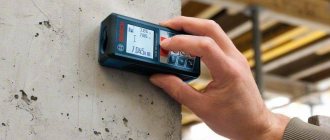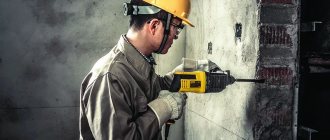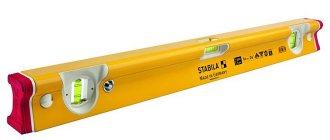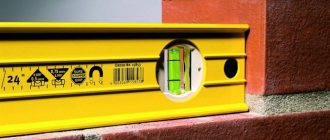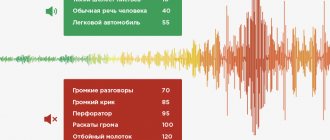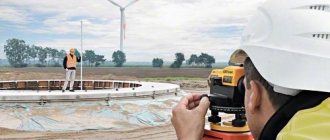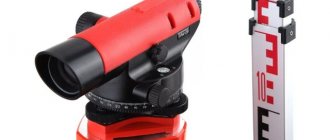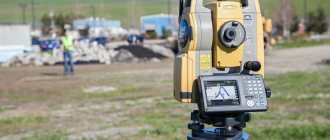Level - features of using the device
The purpose of the level is to determine the difference resulting from differences in the levels of placement of individual points in space, in relation to the surface adopted during measurement. Specialists in the field of geodesy and topography use the device to study the features of the relief, and the construction level is used by workers to comply with the specified parameters during construction and installation work, as well as when carrying out repairs of varying degrees of complexity.
In fact, this device allows you to level the surface in a horizontal or vertical plane and give the object a slope at a given degree.
In open areas you can:
- mark the area for the foundation;
- carry out a breakdown of the personal plot along the lines of planting vegetation;
- plan the arrangement of paths in the garden;
- carry out land management work.
In construction and repair work it becomes possible to:
- mark lines for placing communications;
- adjust the horizontal floor and vertical for the walls;
- assess the correct installation of skirting boards and ceilings;
- install windows and doors correctly;
- install built-in furniture.
Purpose of the level
One of the most important geodetic works carried out during the construction of any objects is leveling.
For these purposes, an appropriate tool is used - a level.
The purpose of this operation is to determine the difference in heights of specific points on the ground, as well as to study landforms.
Levels are used for:
- design and creation of high-precision geodetic structures;
- installation of technical equipment and structures, for example, for installing power transmission poles;
- decorating the area, leveling large areas;
- predicting the amount of subsidence of any buildings;
- construction work indoors, for example, installation of floors and ceilings.
In everyday life, levels are often used when renovating premises.
For these purposes, there is a separate type of device, which is often called laser levels.
They project laser beams onto flat surfaces and are great for marking corners.
Among other things, the use of a laser level ensures the accuracy of laying tiles and any material where right angles and lines are required.
For this reason, the device is also used for wallpapering, where it is necessary to maintain strictly vertical joint lines.
The level will also be useful for an electrician.
With its help, you can clearly position the location of sockets, switches, safety panels at the same level from the floor, or relative to the horizon.
Also in everyday life, the simplest hydrostatic levels are used, operating on the principle of two communicating vessels with liquid.
Advantages
In the photo of the level you can see different modifications of the device, but modern models have the following advantages:
- Resistance to environmental factors.
- High level of measurement accuracy.
- Availability of a function for saving data on storage media.
- Easy to use.
- Compactness and design convenience.
- Affordable price.
Which level is better to buy for monolithic construction
Let's look at how to choose a level for building a house - an apartment building. The peculiarities of leveling in monolithic house construction are that you have to work on large areas and extended objects. An optical level with increased accuracy requirements, or a laser rotational level (working with a receiver) will help here. Internal work (for example, measuring a span of several tens of meters, etc.) in an apartment building also requires increased accuracy and a measurement range of about 100-150 meters.
Accuracy of measurements
The degree of measurement accuracy of devices may vary depending on the conditions and purposes of use:
- highly accurate with an accepted square error in measurements of 0.2-0.5 mm per 1 km of double stroke;
- accurate with an error of 0.5-2.0 mm for each kilometer of travel;
- technical, having an accepted error value of 2.0-10.0 mm per 1 km of double stroke.
Read here: A good background radiation dosimeter - household and professional models and features of their choice
Device selection
The choice depends on the application. Based on this, the necessary parameters are selected. The main characteristics of the level are as follows:
- Range. For household use, 10-40 m is suitable, which is enough for interior work and construction work on the site when constructing, for example, a foundation. For professional devices, this parameter can be up to 100 m, and sometimes up to 600 m.
- Wavelength and number of rays. The number of projections can reach 5 units. This parameter affects the available options during construction and installation work. The wavelength is typically 635 nanometers. Some expensive models use a green tint beam.
- Error. The minimum value of the error gives high measurement accuracy, however, the cost of such devices will be higher.
- Temperature limit within which operation is possible. If you plan to work in the cold, then it is advisable to choose electronic models with a tolerance of -20 to +40°C.
- Dimensions and weight of the product.
- Methods of installation on site.
The use of modern models of levels in construction and repair work allows you to accurately measure distances between points and determine height differences. When choosing a device, it is advisable to choose those technical parameters that will be involved in specific types of work.
Detailed Specifications
Among beginners and professionals, the most popular levels are optical, laser or digital. Below they will be discussed in more detail.
Description of optical-mechanical devices
Until recently, such devices were considered the most used in all areas where they were needed. They are distinguished by an affordable price , with their help measurements are made with maximum accuracy, and they also reliably show themselves in use regardless of the conditions.
The key element of such a device is a spotting scope with a magnification of 20−34 times. It stands on a tribrach and the height can be adjusted. The device also has a cylindrical level designed for horizontal alignment, as well as an elevation screw to make it easier to navigate in space.
Before starting work, the level must be placed on a tripod , and then strictly leveled horizontally using lifting screws. This position can be determined using the built-in bubble level. Then, using the sighting device, the tube is aimed at the supplied staff, and then adjusted for sharpness by rotating the eyepiece ring.
Precise fixation on the staff is carried out using the aiming and focusing screws, all readings will be taken and recorded, after which you can proceed to the second point.
Laser devices, their applications and types
Laser levels have recently become very popular and are confidently relegating old optical devices to the background. Compared to them, they have such advantages as:
- convenience and ease of use;
- compact size;
- versatility.
With the help of modern laser devices, it is possible not only to accurately carry out measurements in the traditional form, but also to simultaneously build perfectly straight lines along several planes. The operation of this device is based on the flow of light. It focuses on the terrain as a clear line or bright spot using a lens system. And the light is emitted through a special LED located in a plastic case along with the lenses. The case helps protect the system from shock, damage and contamination, and it also contains a built-in level that helps level the devices horizontally.
Working with such devices is very easy and simple. The laser is placed on a flat surface or a tripod and leveled. Using a directed beam, a point or line is marked on the surface that is needed for work. When geodetic work in open areas, the rays are directed onto the slats, and the data is recorded in a log. Laser devices are more intended for interior construction or repair work , since in bright light and at a long distance the beam may lose brightness and be difficult to see. In addition, the “working” range, as a rule, does not exceed 30 meters.
Other disadvantages of laser devices include high cost, as well as dependence on power supply, without which they cannot work for a long time.
Laser levels are divided into projection and rotational.
Projection devices
Such devices are capable of constructing a plane using a prism . The construction sector ranges from 120 and in some cases up to 180 degrees. The laser beam hits the prism and is scattered. Without a special detector, the construction range is 10-50 meters, and the accuracy is about 0.3 mm/m. Each meter of distance from the device to the wall can create an up-down line error by the specified amount.
Projection levels, in turn, can be point, linear or combined. Spot ones build from 3 to 5 multidirectional points, linear ones are able to project lines both vertically and horizontally, and combined ones can draw both points and lines.
Rotary type levels
In this case, the plane is constructed by rotating the laser beam . Rotation occurs at an adjustable frequency of up to 600 rpm, resulting in a closed line appearing around the device. To obtain a vertical plane, it must be rotated 90 degrees.
These levels are suitable for working over long distances. And if projection devices with a radiation receiver have a range of up to 100 meters, then for rotary devices this figure will be higher. With their help you can work in large rooms or outdoors, but their cost, compared to projection ones, is higher.
And they also work not only in rotation mode. Some models can build lines or project points in a limited sector. The work is made easier by the presence of a remote direction if you are at a distance from the device.
Digital levels
Digital levels are understood as optical or laser devices, additionally equipped with high-tech electronics. When they receive a signal, they automatically reflect the required indicators.
First, the level is installed in the right place and in the right position, then it is aimed at the installed barcode staff. Next, the report is taken by pressing a button. All received information will be immediately displayed on the monitor, and some models allow you to make the calculations required for the work on the spot. All information can be stored in the device’s memory and transferred to another medium.
This option is ideal for work, but its cost is too high. Such levels are used mainly on large and complex objects, in particular, during the construction of dams, bridges, tunnels, etc.
Above you learned what levels are and what types they come in. But before you start working with these devices, you need to carefully read their instructions and strictly follow all the recommendations given there. Remember that accurate data can only be obtained if this device is used correctly .
